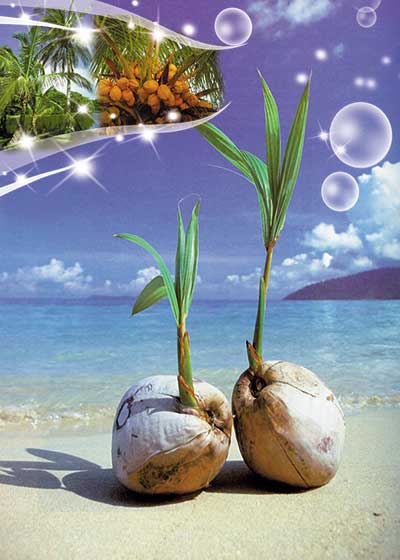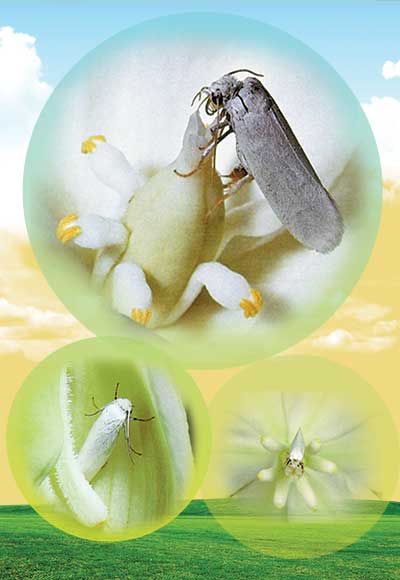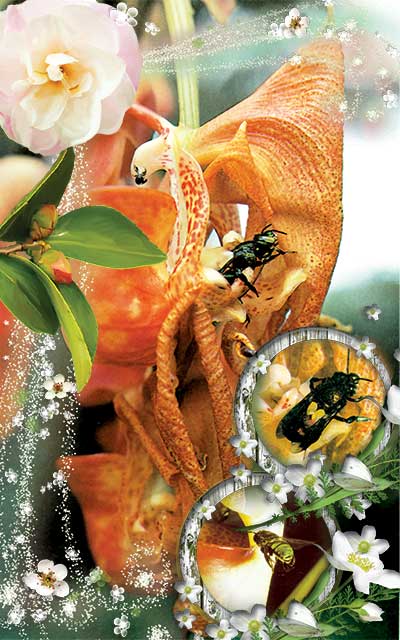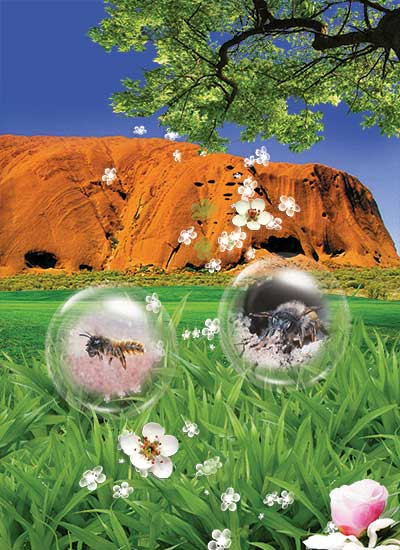Bigotry: The Dark Danger
Magnificence Everywhere
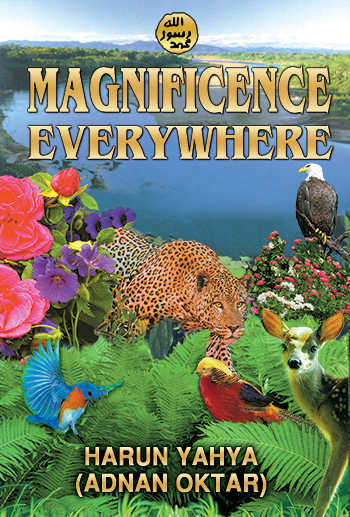
DOWNLOAD THE BOOK
CHAPTERS OF THE BOOK
- Magnificence Everywhere (1/15)
- Magnificence Everywhere (2/15)
- Magnificence Everywhere (3/15)
- Magnificence Everywhere (4/15)
- Magnificence Everywhere (5/15)
- Magnificence Everywhere (6/15)
- Magnificence Everywhere (7/15)
- Magnificence Everywhere (8/15)
- Magnificence Everywhere (9/15)
- Magnificence Everywhere (10/15)
- Magnificence Everywhere (11/15)
- Magnificence Everywhere (12/15)
- Magnificence Everywhere (13/15)
- Magnificence Everywhere (14/15)
- Magnificence Everywhere (15/15)
< <
4 / total: 15
Magnificence Everywhere (4/15)The Seeds of The Coconut Palm
The seeds of some plants are dispersed by water. These seeds typically have characteristics different from the seeds of other plants. For example, plants which disperse their seeds by water possess a structure that minimizes their weight and maximizes their surface area. In addition, the floating tissue might take any of several shapes. The cells filled with air might have a spongy structure or the air might be locked in the seed in such a way that gaps among the cells are almost lost, enabling the seed to float. In addition, the cell walls of the floating tissue are structured in such a way as to prevent water from entering. Besides all this, there is an additional interior segment in these plants which protects the embryo that contains all the genetic information about the plant.2 Among those seeds carried by water, there are seeds that can remain in the water for about 80 days without being spoiled or germinating owing to their strong structure. The most famous of these are the seeds of the coconut palm tree. The seed of the palm is put into a hard shell for safe transport. In this hard shell, everything that is needed for a long journey, including water, is available. Also, the outer part is covered with a strong fabric that prevents the seed from being damaged by water. One of the most significant features of a coconut seed is that it has air spaces that make it buoyant and capable of floating on water. Because of these characteristics, the coconut seed can be carried by ocean currents for thousands of kilometers. When it washes ashore, the seed germinates and grows into a coconut palm tree.3 It is quite an exceptional situation that the coconut seeds germinate just as they reach the land because, as is known, plant seeds generally germinate as soon as they meet water. Yet, this is not true for coconut plants. With their distinctive structures, plants which disperse their seeds by water are privileged in this respect. If these plants, too, began to germinate as soon as they encountered water, they would have long ago since become extinct. However, by means of their mechanisms suitable to their particular environments, these plants can continue to exist. It is evident that these precise features and design could not have come into being by the methods evolutionists claim. The amount of reserved nutrition and water in the seeds, the period of their reaching the land, in short all the delicate calculations made for such features have been perfectly determined by Allah, Who is the owner of eternal power and wisdom. Living Things Created in Harmony with Each Other
In some plants, the nectar is present in the depths of the plants' flowers. It seems that this would constitute a disadvantage making it difficult for insects and birds to collect nectar and hence for flowers to be pollinated. However, Allah has enabled these plants to be pollinated as well by creating living creatures whose structures are exactly appropriate for the characteristics of flowers that keep their nectars in their depths. The concordant relationship between the chandelier tree and the yucca moth is one such example. The yucca has a rosette of spear-shaped leaves and, in the center of this, there is a stalk bearing cream-colored flowers. One of the features of the yucca is that its pollen exists in a curved region. For this reason, only a certain moth species that has been bestowed with a curved proboscis can collect the pollen, which is present in the male reproductive organs of the plant. By pressing the pollen against each other, the moth forms the pollen it has collected into a ball shape and takes this to another yucca. First it goes down to the bottom of the flower and lays its eggs. Then it climbs up to the top of the flower and, by hitting the pollen ball, causes pollen to spill. After a while, moth caterpillars will get out of the eggs and feed on this pollen. In the meantime, by hitting the pollen ball that was collected from the previous flower against the top of the new flower, the moth pollinates it. If moths did not exist, yuccas could not pollinate on their own.4 As we can see, the nourishment of the moth and the pollination of the yucca come about in a very harmonized way. What creates this harmony is not the yucca itself or the moth. It is not possible for a plant or an insect to be aware of the needs of another creature or to determine a tactic for fulfilling its own needs. These creatures do not possess the faculty of thinking and thus cannot discover methods and teach them to other creatures. Allah alone has created this perfect harmony among living creatures. Both creatures are the work of Allah, Who knows them perfectly, Lord of all the worlds and All-Knowing. And they in turn serve the purpose of introducing people to the greatness, might and perfect art of Allah. Allah reveals this in the Qur'an: The seven heavens and the earth and everyone in them glorify Him. There is nothing which does not glorify Him with praise but you do not understand their glorification. He is All-Forbearing, Ever-Forgiving. (Surat al-Isra: 44) The Tactics of Coryanthes Orchids
Is it possible for a flower to be aware of the preferences of an insect? Is it possible for it to make plans to make this insect fall into its trap and make changes in itself accordingly? Without a doubt, it is not possible for a flower or an insect to carry out such tactics by means of its own reason and will. However, when we look at the creatures in nature, we see that they often apply just such kinds of tactics. The Coryanthes orchid is one such plant that makes insects fall into its trap by means of an interesting tactic. The reproductive system of the orchid is based on attracting insects and making them carry its pollen. The flowers of this orchid species grow in clusters. Each flower has two wing-like sepals and just behind these leaves is a tiny "bucket." When the flowers open, a special liquid secreted by two special glands begins to drip into the bottom of this bucket. After a while the flower begins to emit a fragrance that bees find irresistible. As the orchid blooms, male bees respond to the scent and begin to fly around the flower. While they try to land on the vertical edges of the orchid, they also look for a place to hang onto with their legs, like the tubular section of the flower that connects the bucket to the stem. This part is slippery and sloping. Therefore, the bees creeping around the flower inevitably fall into the bucket in the bottom of the flower that is filled with the liquid. There is only one way out for the bee that has fallen into the flower. A narrow tunnel leads to the front wall of the flower, that is, to daylight. Until the insect finds this way out, which is at the same level as the liquid into which the bee has fallen, it keeps swimming in the liquid. While trying to find the exit, it passes under the stigma, where there is pollen, and the flower's male organs. At that time, two pollen sacs stick to the back of the insect. Then the insect advances towards the exit and finally leaves the flower. When the bee goes to a new flower, this time the stigma of the flower picks up the pollen from the bee and, in this way, pollination begins.5 Yet, this situation doesn't benefit the flower alone. The liquid present in the flower bucket the bees fall into is extremely important for bees as well, because the male bees will use the odor of this secretion smeared on their bodies to attract female bees during mating. As we said in the beginning, it is not at all possible for a flower to develop tactics to deceive an insect and arrange its structure according to this tactic. Similarly, it is no less impossible for an insect to develop a tactic to acquire a needed substance from a flower by means of its own will. The amazing cooperation between these two creatures is evidence for the fact that they were created by a unique Creator. The Skills of Mason Bees
Mason bees are living creatures that attract attention because of the care they demonstrate in building a nest. When a female bee who wants to build a nest finds a suitable place, she cleans it. However, in order to build a nest, she first needs to find a source of mud. If she cannot find mud, she finds some finely textured soil and turns it into a soft paste by mixing it with her saliva. A mason bee begins its nest construction by scraping a piece of mud from the ground with her jaw. She carries the mud between her legs and molds it into a pellet. She adds more mud to the pellet. Then, holding the pellet with her lower jaw, the female bee comes back to her nest. When the bee comes to the place where she will build a nest with the mud, she does not begin to work in a haphazard, disorganized way. When they build their tunnel-like nests, mason bees always follow a definite plan. In line with this plan, the mason bee uses the first loads of mud to build the back partition of the first cell that will constitute the blind end of the tunnel. Then, she builds up mud in the shape of a crescent at some distance from the partition. This marks the site of the next partition she will build after she lays her egg in the first cell. With the completion of the cell, the mason bee begins to collect food to store there. On her first tour, she stores pollen at the rear of the nest. Over the next tours, she leaves some honey that she makes into a thick paste with her jaws on the pollen she left during her previous tour. In this way, she completes initial preparations for the egg she will lay. As soon as the bee leaves the last pollen load in the nest, she immediately begins to lay her egg. After laying the egg, the female bee begins to build walls for the other mud partition she had marked before. Following a certain sequence, the bee continues the egg-laying and cell-building processes until the cells constituting the nest form a row. The structure of the cells is standard. Each cell contains an egg and stored food and is separated from the adjacent cells by a mud wall. After the last cell is completed and closed, the female bee leaves an empty space between the last brood cell and the nest entrance and finally closes this opening with a thicker plug than an ordinary cell partition. This plug prevents other creatures from making their nests in front of the nest which would imprison the offspring in their cells and lead to their deaths.6 It can be seen at every stage of nest building that there is a clear wisdom and intelligence behind all the conduct of bricklayer bees. In a verse, Allah informs us that bees are creatures that act with the inspiration of Allah. In fact, not only bees, but all the living creatures in the universe are inspired by Allah, the All-Powerful, the Wise.
Notes7- Bates Hayvanlar Ansiklopedisi (Bates Encyclopedia of Animals), C.B.P.C. Publishing Ltd., p. 244. 8- Ali Demirsoy, Yasamin Temel Kurallari (Basic Fundamentals of Life), Meteksan A.Ş., Ankara, 1992, pp. 18-22. 9- Bert Hölldobler-Edward O.Wilson, The Ants, Harvard University Press, 1990, p. 534-535. 10- Geo Magazine, October 1995, p. 186. 11-Anita Ganeri, Creatures That Glow, Marshall Editions, London, 1995, pp. 10-11. |
4 / total 15
You can read Harun Yahya's book Magnificence Everywhere online, share it on social networks such as Facebook and Twitter, download it to your computer, use it in your homework and theses, and publish, copy or reproduce it on your own web sites or blogs without paying any copyright fee, so long as you acknowledge this site as the reference.
